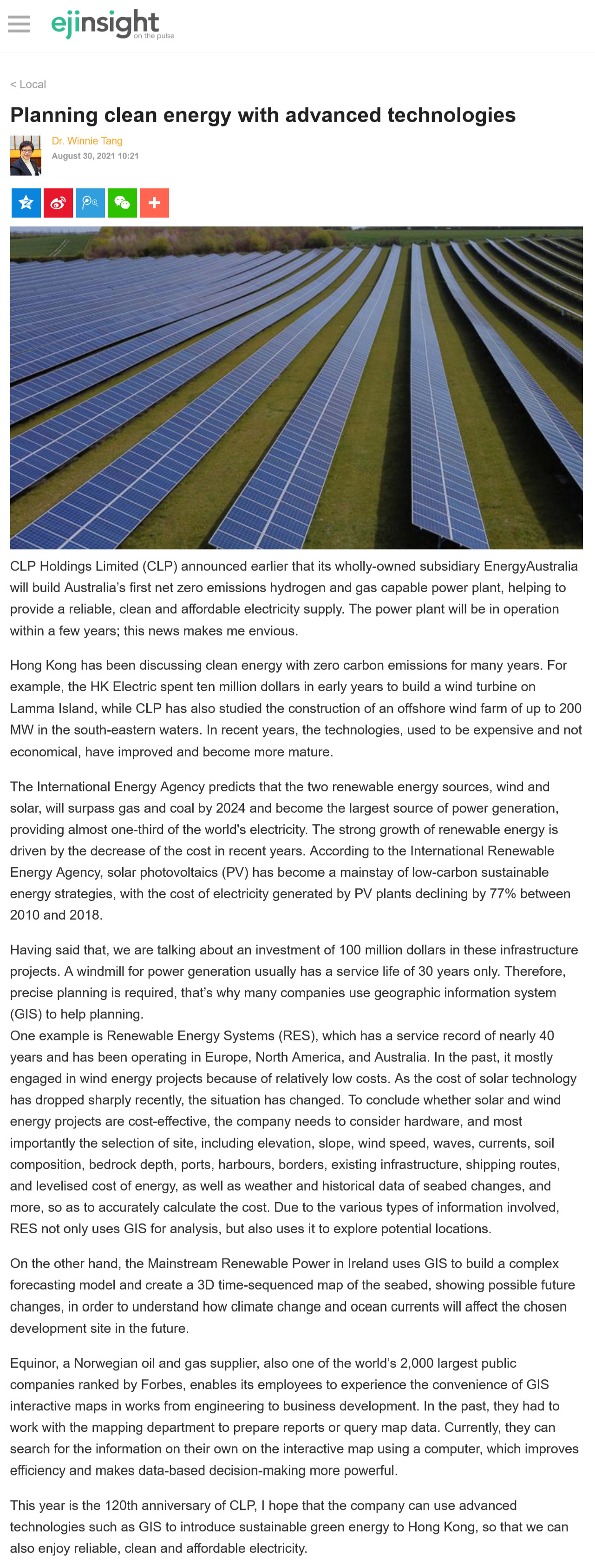網上版請按此

Planning clean energy with advanced technologies
CLP Holdings Limited (CLP) announced earlier that its wholly-owned subsidiary EnergyAustralia will build Australia's first net zero emissions hydrogen and gas capable power plant, helping to provide a reliable, clean and affordable electricity supply. The power plant will be in operation within a few years; this news makes me envious.
Hong Kong has been discussing clean energy with zero carbon emissions for many years. For example, the HK Electric spent ten million dollars in early years to build a wind turbine on Lamma Island, while CLP has also studied the construction of an offshore wind farm of up to 200 MW in the south-eastern waters. In recent years, the technologies, used to be expensive and not economical, have improved and become more mature.
The International Energy Agency predicts that the two renewable energy sources, wind and solar, will surpass gas and coal by 2024 and become the largest source of power generation, providing almost one-third of the world's electricity. The strong growth of renewable energy is driven by the decrease of the cost in recent years. According to the International Renewable Energy Agency, solar photovoltaics (PV) has become a mainstay of low-carbon sustainable energy strategies, with the cost of electricity generated by PV plants declining by 77% between 2010 and 2018.
Having said that, we are talking about an investment of 100 million dollars in these infrastructure projects. A windmill for power generation usually has a service life of 30 years only. Therefore, precise planning is required, that's why many companies use geographic information system (GIS) to help planning.
One example is Renewable Energy Systems (RES), which has a service record of nearly 40 years and has been operating in Europe, North America, and Australia. In the past, it mostly engaged in wind energy projects because of relatively low costs. As the cost of solar technology has dropped sharply recently, the situation has changed. To conclude whether solar and wind energy projects are cost-effective, the company needs to consider hardware, and most importantly the selection of site, including elevation, slope, wind speed, waves, currents, soil composition, bedrock depth, ports, harbours, borders, existing infrastructure, shipping routes, and levelised cost of energy, as well as weather and historical data of seabed changes, and more, so as to accurately calculate the cost. Due to the various types of information involved, RES not only uses GIS for analysis, but also uses it to explore potential locations.
On the other hand, the Mainstream Renewable Power in Ireland uses GIS to build a complex forecasting model and create a 3D time-sequenced map of the seabed, showing possible future changes, in order to understand how climate change and ocean currents will affect the chosen development site in the future.
Equinor, a Norwegian oil and gas supplier, also one of the world's 2,000 largest public companies ranked by Forbes, enables its employees to experience the convenience of GIS interactive maps in works from engineering to business development. In the past, they had to work with the mapping department to prepare reports or query map data. Currently, they can search for the information on their own on the interactive map using a computer, which improves efficiency and makes data-based decision-making more powerful.
This year is the 120th anniversary of CLP, I hope that the company can use advanced technologies such as GIS to introduce sustainable green energy to Hong Kong, so that we can also enjoy reliable, clean and affordable electricity.
Dr. Winnie Tang
Adjunct Professor, Department of Computer Science, Faculty of Engineering; Department of Geography, Faculty of Social Sciences; and Faculty of Architecture, The University of Hong Kong